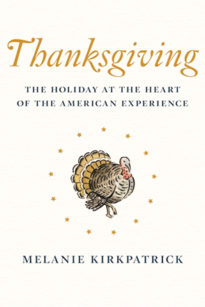By the 1860s, all states celebrated some form of the classic New England meal we enjoy today—but the Thanksgiving holiday was not nationalized until 1863, after years of campaigning by author, editor, social reformer, and abolitionist, Sarah Josepha Hale.
Hale first wrote about Thanksgiving in 1827 her novel Northwood, devoting a full chapter to the meal. Though fictional, the scene in Northwood was inspired by the Thanksgiving feasts Hale enjoyed during her childhood in rural New Hampshire.
Melanie Kirkpatrick relates Hale’s Northwood meal in Thanksgiving: The Holiday at the Heart of the American Experience:
In Hale’s telling, the turkey was the king of the day: “The roasted turkey took precedence on this occasion, being placed at the head of the table,” she wrote, “and well did it become its lordly station, sending forth the rich odor of its savory stuffing, and finely covered with the froth of the basting.”
Like Juliana Smith’s description of her Thanksgiving dinner in 1779, the menu of Hale’s fictional dinner was heavy on meat. Opposite the turkey, at the foot of the table, was “a sirloin of beef, flanked on either side by a leg of pork and loin of mutton.” Also on the table were a goose, two ducklings, and an enormous chicken pie, “formed of the choicest parts of fowls, enriched and seasoned with a profusion of butter and pepper, and covered with an excellent puff paste.” She hailed the chicken pie as “an indispensable part of a good and true Yankee Thanksgiving.”
That was the first course. The second course—dessert—was arrayed on a heavily laden sideboard. There were a huge plum pudding, “custards and pies of every name and description,” several kinds of cake, and a variety of fruits. Among all these, the “celebrated” and also “indispensable” pumpkin pie “occupied the most distinguished niche.” There were drinks on the sideboard, too: currant wine, cider, and ginger beer. All the beverages were homemade; no imported wine or spirits were offered. At the conclusion of the meal, the sated diners were “sorrowful” that they could not eat more.
In the second edition of Northwood, published in 1852 and subtitled Life North and South, Hale expanded on the notion of Thanksgiving as a national event:
“Is Thanksgiving Day universally observed in America?” inquired Mr. Frankford [an Englisman on a visit to New England].
“Not yet, but I trust it will become so. We have too few holidays. Thanksgiving, like the Fourth of July, should be considered a national festival observed by all our people.”
In 1863, after years of Hale’s campaigning and editorializing in her influential magazine, Godey’s Lady’s Book, President Lincoln issued a proclamation that enshrined Thanksgiving as a national holiday. In a gesture to heal a divided nation at the close of our bloody Civil War, Lincoln’s proclamation called on the American people to celebrate Thanksgiving “with one heart and voice.”
Thanks to her efforts, Hale is today known as “The Godmother of Thanksgiving.”
Drawing on her Northwood as inspiration, the editors at Encounter Books crafted this Thanksgiving punch in honor of Sarah Josepha Hale.
Encounter’s Thanksgiving Punch
2 cup Goslings dark rum
2 cup Apple Cider
2 cup Ginger Beer
1/4 cup Tart Cherry Juice (or cranberry)
A few dashes of bitters to taste
2 Apples (diced)
2 Oranges (sliced)
8 Cinnamon sticks
Procedure:
Layer cider, spiced rum, ginger beer, tart cherry juice in a large pitcher or serving bowl to taste (tip: add spiced rum first, then cider to give your final product a nice ombre color.)
Garnish with cinnamon sticks and diced fruit.
Taste your punch and adjust ingredients as necessary (Tip: if punch is too sweet, add a few dashes of bitters and stir well.)
Yields 5-6 glasses of punch.
Best served cold over ice.
Enjoy this festive cocktail with holiday readings from Melanie Kirkpatrick’s Thanksgiving: The Holiday at the Heart of the American Experience.
This piece features writings from Melanie Kirkpatrick’s Thanksgiving: The Holiday at the Heart of the American Experience. Copyright Encounter Books. Encounter Books is an activity of Encounter for Culture and Education, a tax-exempt, non-profit corporation dedicated to strengthening the marketplace of ideas.
